The Great American Road Trip is a travel tradition made even more popular through the decades by literary titans such as Kerouac and Steinbeck. Chances are, if you’ve been cooped up for a while, the thought of a road trip is sounding pretty nice right about now.
Well, here’s some good news: it doesn’t just have to be a far-fetched daydream. Road trips can provide travelers the flexibility and safety they need in order to navigate the world of travel since the pandemic began — not to mention gas and car rentals are pretty inexpensive currently.
We surveyed 1,000 people who had taken at least one road trip since the onset of the pandemic. They reported the different ways they’re staying safe, how they’re getting from point A to point B, and what their future travel plans look like. If you’re thinking of hitting the road yourself, finding out what these travelers had to say could be incredibly illuminating.
The Changing American Road Trip
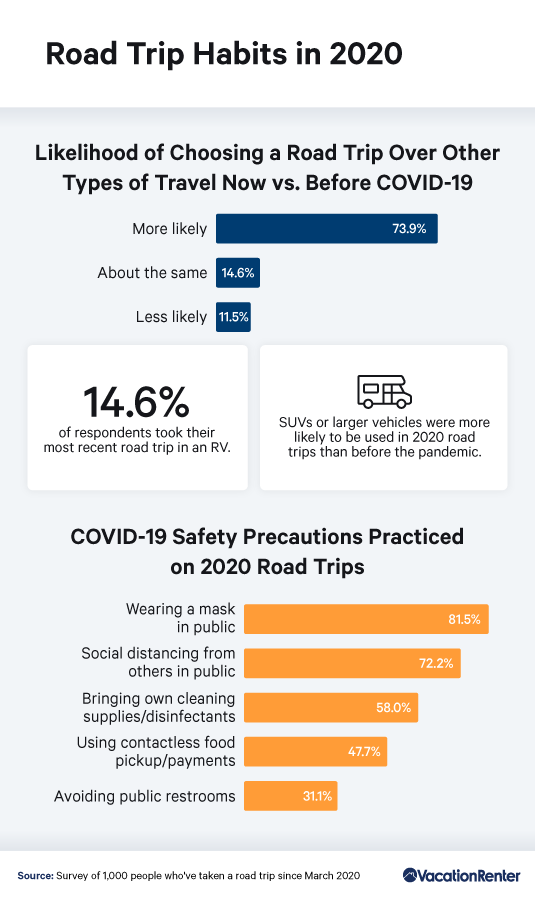
Our study began with a look into some high-level ways the great American road trip has changed since March 2020. Respondents reported how their likelihood of taking a road trip has evolved over time, as well as the safety precautions they’ve been taking.
After the onset of COVID-19, travelers are seeing road trips as much more appealing. In fact, 73% agreed they were much more likely to choose road trips over other types of travel at this time compared to before the pandemic hit. Road trips offer people the ability to socially distance, sanitize their own surroundings, and, of course, enjoy the great outdoors.
72.2% of respondents took advantage of the ability to social distance on the road, and 81.5% of respondents took precautions by wearing masks in public places during their travels. Bringing personal cleaning supplies — a good idea to have both in and out of the car — was also a new road trip habit for 58% of the road trippers we spoke to. By following these safety procedures, respondents were able to enjoy the benefits of a vacation, even in unusual circumstances.
Road Trips Before and After the Pandemic
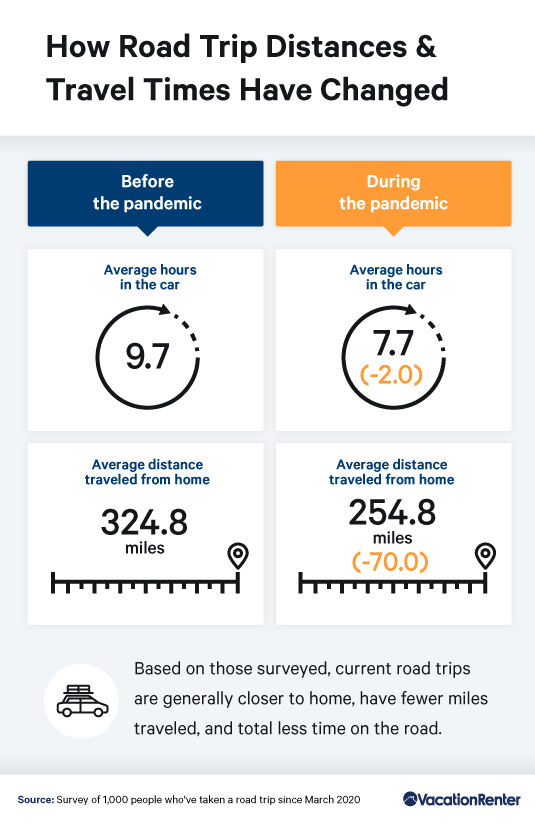
Our study then looked at how distances and travel times have changed since the pandemic. We compared our findings to pre-COVID road trip statistics and found that things are definitely not the same.
While respondents expressed wanting to take even more road trips now, they also tended to keep each trip shorter in terms of time and distance. Prior to 2020, the average road trip was 9.7 hours round trip. Since the pandemic, however, this duration shrank by two hours.
Fortunately, traveling by car or RV offers the flexibility to head home whenever you want. If distance is a concern, you can plan your trip accordingly, and venture further if things feel right. This trend isn’t just confined to cars and RVs — traveling closer to home has been a trend we’ve seen rising when it comes to every single mode of transportation.
The Driving Force Behind Road Trips in 2020
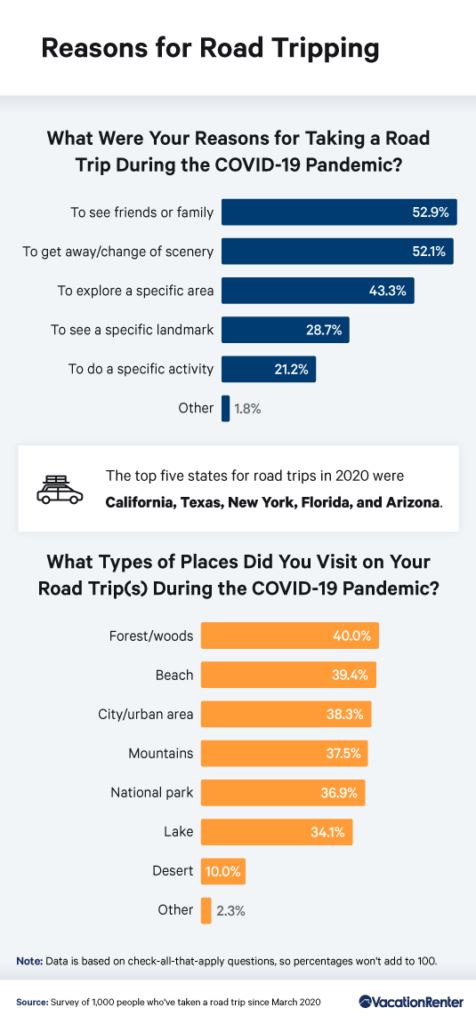
The top reason respondents reported as an impetus for taking road trips in 2020 was indicative of the times we’re living in. As social distancing cut down on interactions with family and friends this year, 52.9% of the people we surveyed said that seeing friends and family was a motivator behind their most recent road trip this year. That said, about the same percentage of road trippers just wanted to get away. Whether craving some time outside of the house or heading to see relatives, 40% of people took a pit stop in the forest or woods, while 39.4% visited a beach. When we asked road trippers which states were inspiring them to hit the open road the most, the top five destinations were California, Texas, New York, Florida, and Arizona.
Road Trip Roofs and Rations
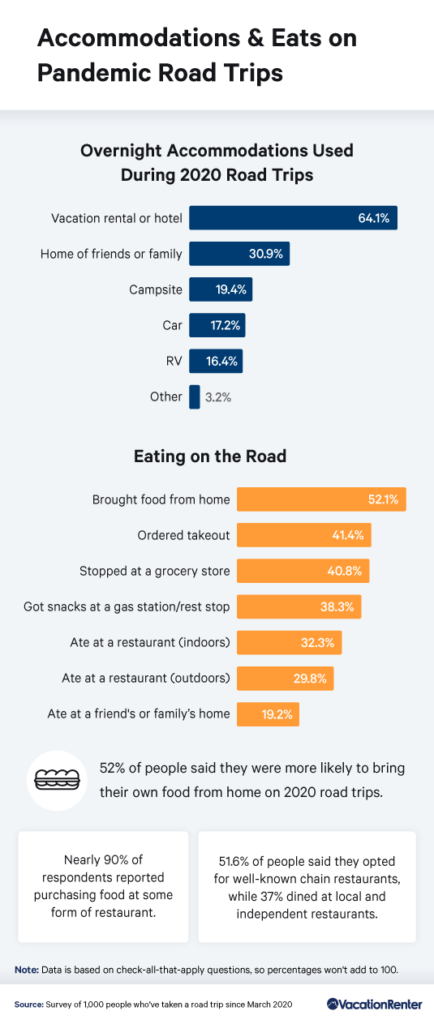
When considering social distancing, accommodations and food arrangements can require a bit more thought since the pandemic began, but this didn’t seem to deter the road trippers we surveyed.
Vacation rentals and hotels were the top accommodation of choice for lodging, with 64.1% reporting using at least one during road trips this year. In the wake of the pandemic changing our daily norms, rentals and hotels have instituted more stringent cleaning and hygiene policies to ensure guest safety and comfort.
When it came to eating, 51.6% of respondents opted for large chain restaurants as opposed to local, independent eateries. While chains offer familiarity and often have greater resources for COVID-responses — which may be particularly appealing to travelers right now — it’s the small business owners who have consistently struggled throughout the pandemic. Plus, they’re likely taking precautions based on local regulations and recommendations.
Future Travels
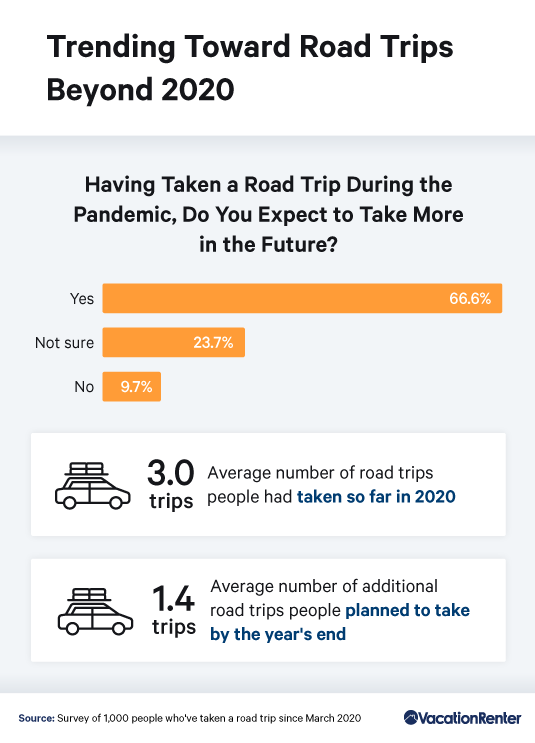
To glean more insight into people’s plans, we asked about road trip plans for the rest of the year. Did people intend to take more this year? What about further into the future?
Road trippers didn’t seem to have any intention of forgoing more road travel. With an average of three road trips already under their belts this year, respondents reported planning to take an additional 1 to 2 trips with only two months left in the year. Beyond 2020, two-thirds of respondents agreed that, even after the pandemic, they still intend to take more road trips.
A Safe and Optimistic Future for Road Travel
When traveling, safety is of course paramount, especially today. Fortunately, road trippers consistently reported taking COVID-19 safety precautions while still enjoying getaways to see friends and family. In 2020, a little getaway could be just what the doctor ordered.
If a road trip happens to be calling your name, VacationRenter is here to make it easy for you. We’ve compiled and organized all of the best booking site listings into one easy place, so you can be sure you’re getting the best deals at the best destinations. If you’re ready to start browsing or are planning your next adventure, head to VacationRenter today.
Methodology
We surveyed 1,000 people who had taken a road trip since the onset of the COVID-19 pandemic. Respondents were 43.9% women and 56.1% men. The average age of respondents was 37.8 with a standard deviation of 11.8.
When reporting how likely they are to take a road trip since the pandemic compared to before, respondents were given the following scale of options:
- Much more likely to choose a road trip
- Somewhat more likely to choose a road trip
- About as likely to choose a road trip
- Somewhat less likely to choose a road trip
- Much less likely to choose a road trip
In our final visualization of the data, we condensed these to three groups: more likely, about the same, and less likely.
When reporting the safety precautions they took, the types of accommodations they used, what food options they used, where they went, and their reasons for taking road trips this year, people were instructed to select all options that applied to them. Therefore, the data could include information for multiple road trips, and percentages won’t add to 100.
All averages presented in the project were calculated to exclude outliers.
Limitations
The data we are presenting rely on self-report. There are many issues with self-reported data. These issues include, but are not limited to, the following: selective memory, telescoping, attribution, and exaggeration.
Fair Use Statement
In an unusual year, road trips are a good option for getting away while staying safe. If someone you know would benefit from the information in this project, you are able to share for any noncommercial reuse. Please link back here so the entire project and its methodology can be viewed. This also gives credit to our contributors who make this work possible.